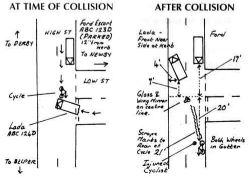To the cyclist who’s just had an altercation with a vehicle, the onus is on the driver, irrespective of liability, to proffer their personal name and address, likewise that of the Registered Keeper if different and insurance details. The cyclist should record registration (VRN) and description (gender, age, ethnicity) of the driver.

If all you’ve been given is a name and a phone number, that’s not good enough and merits a Report to the Police forthwith. S 170 Road traffic Act 1988 imposes the obligation to provide details and to report to the Police if these details are not provided. Any collision resulting in injury is compulsorily reportable.
Nowadays, a cyclist armed with the VRN and date of the collision can check the Motor Insurers Database ( askMID- Enquiry) on line and for a £10 fee find the Insurer’s details (or not, as the case may be, in which circumstance the Police ought to be interested). The DVLA site also informs if the vehicle is taxed and has an MOT (check-mot.service.gov.uk)
Next Steps:-
The following information about the collision will have to be provided in the Claim Notification to the vehicle Insurer: –
- the location of the incident including the description of the road by name and/or number
- the identity of all parties involved in the incident
- Vehicle registration and Insurance Policy number (Motor Insurers Database check)
- the direction of travel of those involved immediately prior to the collision
- the light and weather conditions immediately prior to the collision
- a summary of the allegations of negligence to be made against the erring motorist for example what is the cause of the collision
- full details of the injuries sustained and the losses incurred so far as currently known.
From the scene, these details are useful:
- any points of reference including street lights, bus stops, junctions, traffic lights etc
- measurements of the road including width of the carriageway, distances from junctions, traffic islands etc
- any marks upon the road surfaces relevant to the incident, for example skid marks, scrape marks etc
- any pile of debris including, dried mud, glass, bicycle materials, rusty metal in order to indicate the point of impact
- any area of scattered glass which may assist an investigation consultant in determining the pre-collision positions of the vehicles involved
- the positions of the vehicles immediately after the impact.
An adult has 3 years to bring a claim, although many law firms are jumpy if time has elapsed. It’s best to do homework and find a representative before trails go cold.
